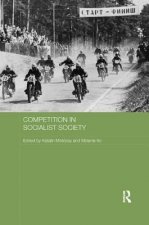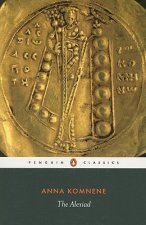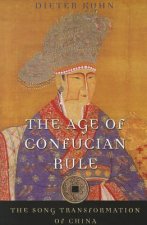
Kód: 02029495
Stakhanovism and the Politics of Productivity in the USSR, 1935-1941
Autor Lewis H. Siegelbaum
This is the first study in English of a major and instructive episode in the history of the Soviet Union. The Stakhanovite movement commemorated the mining of 102 tons of coal by Aleksei Stakhanov on August 30–1, 1935, and it was ... celý popis
- Jazyk:
 Angličtina
Angličtina - Vazba: Brožovaná
- Počet stran: 344
Nakladatelství: Cambridge University Press, 1990
- Více informací o knize

Mohlo by se vám také líbit
-

Sozialistischer Wettbewerb. Maßstab für die Haltung zum Volkseigentum?
1084 Kč -

Translations into Greek and Latin Verse
1426 Kč -

Competition in Socialist Society
1774 Kč -

Why We Can't Wait
229 Kč -

Essay Upon Projects
1143 Kč -

Weltuntergang
479 Kč -

Remapping Ethiopia
821 Kč -

Contrast-enhanced ultrasound
1068 Kč -

Coll & Tiree
403 Kč -

Proliferation of Child Pornography on the Internet - Scholar's Choice Edition
504 Kč -

Intelligence Agencies
532 Kč -

To Amend the Federal Credit Union ACT to Clarify Existing Law with Regard to the Field of Membership of Federal Credit Unions, to Preserve the Integri
559 Kč -

I'm Tim Maude, and I'm a Soldier
834 Kč -

Sozialistischer Wettbewerb und umfassende Intensivierung
3944 Kč
Darujte tuto knihu ještě dnes
- Objednejte knihu a zvolte Zaslat jako dárek.
- Obratem obdržíte darovací poukaz na knihu, který můžete ihned předat obdarovanému.
- Knihu zašleme na adresu obdarovaného, o nic se nestaráte.
Více informací o knize Stakhanovism and the Politics of Productivity in the USSR, 1935-1941
Nákupem získáte 175 bodů
 Anotace knihy
Anotace knihy
This is the first study in English of a major and instructive episode in the history of the Soviet Union. The Stakhanovite movement commemorated the mining of 102 tons of coal by Aleksei Stakhanov on August 30–1, 1935, and it was an important symbol by which the state urged workers to achieve greater productivity. As Lewis Siegelbaum demonstrates, Stakhanovism can be used to explore the social relations within Soviet industry at a critical stage in its development. In this sense, Stakhanovism was an important symbol of a shift in official priorities from construction of the means of production via increasing inputs of labor, to intensive use of capital and labor. Siegelbaum argues that Stakhanovism evolved neither as the product of a master plan nor of spontaneity from below. It developed in response to economic and political contingencies, local initiatives and inertia, and the maneuvering of workers and their bosses alike. Stakhanovism was the characteristic mode of what he calls 'the politics of productivity'. Stakhanovites did not constitute an aristocracy of labor, but rather were a diverse and often changing group. For all but a relative few, Stakhanovite status was provisional, depending as much on managerial favoritism and technical assistance as on individual skill and ambition. Eventually, however, Stakhanovites assumed a number of roles, including that of informers against managers, party officials, and engineers. Many were rewarded for their services by promotion to managerial and technical positions. As 'cultured' individuals who supposedly led fulfilled and contented lives during non-working hours, Stakhanovites served an integrative function that was perhaps more important than their contributions to production. Through an interpretation of Stakhanovites as models of the New Soviet Man, this book advances a unique contribution to our understanding of Soviet life in the 1930s.
 Parametry knihy
Parametry knihy
Zařazení knihy Knihy v angličtině Humanities History Regional & national history
1749 Kč
- Plný název: Stakhanovism and the Politics of Productivity in the USSR, 1935-1941
- Autor: Lewis H. Siegelbaum
- Jazyk:
 Angličtina
Angličtina - Vazba: Brožovaná
- Počet stran: 344
- EAN: 9780521395564
- ISBN: 0521395569
- ID: 02029495
- Nakladatelství: Cambridge University Press
- Hmotnost: 1500 g
- Rozměry: 216 × 138 × 25 mm
- Datum vydání: 29. June 1990
Oblíbené z jiného soudku
-

Hundred Years' War on Palestine
338 Kč -

Ethnic Cleansing of Palestine
358 Kč -

History of Japan
405 Kč -

Ten Myths About Israel
336 Kč -

Strange Death of Europe
410 Kč -

Decline and Fall of the Roman Empire
130 Kč -

Secret History
320 Kč -

God's Playground A History of Poland
1700 Kč -

Mayflower
385 Kč -

How to be a Victorian
357 Kč -

Plantagenets
331 Kč -

General's Son
428 Kč -

Iran: A Very Short Introduction
225 Kč -

Twenty Years A-Growing
249 Kč -

Cuneiform
276 Kč -

History of Witchcraft in England from 1558 to 1718
453 Kč -

China in Africa
894 Kč -

Islandman
249 Kč -

Bohemian Paris
414 Kč -

Lancaster And York
490 Kč -

Alexiad
423 Kč -

Inside Hitler's Greece
513 Kč -

Modern France: A Very Short Introduction
233 Kč -

Diana: Her True Story - In Her Own Words
306 Kč -

The Fourth Turning
441 Kč -

The Oxford History of Ancient Egypt
383 Kč -

Churchill: The Power of Words
410 Kč -

Palestine
534 Kč -

Korean History in Maps
706 Kč -

Great Gatsby (Wisehouse Classics Edition)
405 Kč -

Viking Way
1144 Kč -

The Thirteenth Tribe
308 Kč -

My Promised Land
358 Kč -

Vanished Kingdoms
514 Kč -

Age Of Revolution
410 Kč -

Life and Death of Anne Boleyn
624 Kč -

Coming of the Third Reich
464 Kč -

Children of Ash and Elm
464 Kč -

Europe Between the Oceans
798 Kč -

Socialism Betrayed
475 Kč -

303 Squadron
452 Kč -

Ancient Celts, Second Edition
623 Kč -

Dancing in the Glory of Monsters
395 Kč -

Battle of Britain: Luftwaffe Blitz (Images of War)
606 Kč -

Age of Confucian Rule
851 Kč -

Beyond Band of Brothers
410 Kč -

Benjamin Franklin
410 Kč -

On China
462 Kč -

Illustrated Encyclopedia of Uniforms of the American War of Independence
543 Kč
Osobní odběr Praha, Brno a 12903 dalších
Copyright ©2008-24 nejlevnejsi-knihy.cz Všechna práva vyhrazenaSoukromíCookies



 Vrácení do měsíce
Vrácení do měsíce 571 999 099 (8-15.30h)
571 999 099 (8-15.30h)